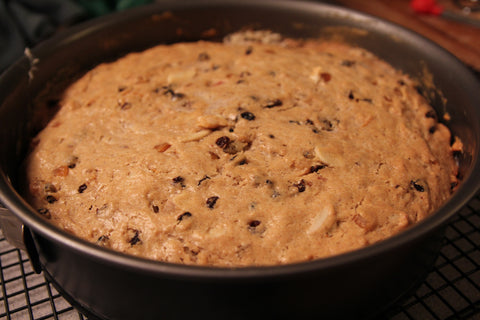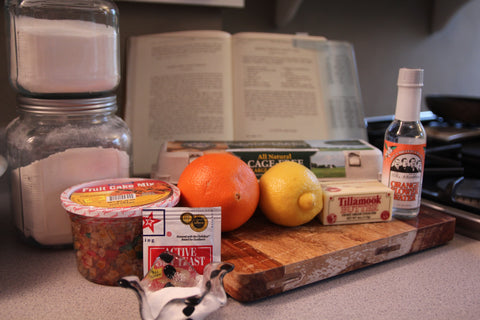Our Blog : Christmas Cake
English Twelfth Cake
This twelfth cake (also known as Three Kings' Cake or King's Cake) is very different from the French twelfth cake. Instead of a yeasty-bread type cake, this cake is much denser, and contains rum-soaked fruit, currants and raisins. It is a much shorter recipe, although it does cook slowly at a low temperature. This recipe also calls for a dry bean and a dry pea - whoever finds the pea and the bean in their pieces are the king and queen of the evening's revelries. As the recipe says - the bean determines the king and the pea determines the queen.


Cake ingredients:
- 1/4 cup white rum
- 1/2 cup golden raisins
- 1/2 cup currants
- 1/2 cup candied fruit pieces (I used a fruit-cake mix)
- 1 cup (2 sticks) unsalted butter
- 3/4 cup sugar
- 4 eggs
- 2 tablespoons milk
- 1/2 teaspoon almond extract
- 3 to 3 1/2 cups flour
- 1 teaspoon cinnamon
- 1/2 teaspoon nutmeg
- 1/2 teaspoon allspice
- 1/2 cup slivered almonds
- Zest of 1 lemon
- 1 dried pea
- 1 dried bean
Instruction for the cake:






Golden Almond Icing Ingredients:
- 2/3 cup slivered almonds
- 1/2 cup sugar
- 1/4 cup unsalted butter, softened
- 1/4 cup white rum
- 2 egg yolks
- 1 or 2 drops almond extract
Instructions for the icing:



Buche de Noel aka Fancy French Log Cake

Ingredients for sponge cake:
- 1 cup cake flour
- Pinch of baking powder
- Pinch of salt
- 4 eggs - separated into whites and yolks
- 1 cup sugar
- 1/2 teaspoon vanilla extract
- 1 tablespoon sugar
- Rum, for sprinkling
- Powdered sugar, for sprinkling
Instructions for sponge cake:
1. Preheat the oven to 400 degrees.2. Sift the flour twice with the baking powder and salt in a medium sized bowl. Set aside.

3. In a separate large bowl, beat the egg yolks with 1 cup of sugar and vanilla extract until very thick and pale yellow - as you keep beating you will see them change color from the rich almost orangey-yellow of egg-yolk to a softer pastel yellow.

4. In a separate bowl (or in the bowl of a stand-mixer, or with a hand-mixer) beat egg whites. As the whites begin to stiffen add 1 tablespoon sugar and continue to beat until the whites hold stiff peaks.

5. Sift the flour-mixture into the yolk-mixture a little at a time, folding after each addition until all dry ingredients are incorporated.

6. Add the whites and fold gently, but thoroughly, using a rubber spatula. This step was the most awkward for me, as the whites were hard to incorporate - but just be patient and keep folding the batter over the whites and it will eventually incorporate into a fluffy, somewhat lumpy, batter.

7. Pour the batter into your cake pan that is lined with buttered parchment paper. Spread the batter evenly over the pan.

8. Bake for 10-15 minutes, until cake is golden brown. Keep an eye on it - this cake is thin!

9. After you remove it from the oven, sprinkle the cake with rum.
10. Remove the cake from the pan by pulling it out on top of the parchment paper, and place the cake on the counter. Sprinkle the top of the cake with powdered sugar, and then place another piece of parchment paper on top of the cake (so the cake is now in the middle of a parchment-paper sandwich). Then take a cooling rack, or cookie sheet and place that on top of the top piece of parchment paper. Now is the tricky part - flipping the cake. We have a pizza peel on hand, and that worked wonderfully to flip the cake over with, but a thin cookie sheet, or just an extra pair of hands would help to flip the whole cake over so you can peel the buttered-parchment paper off.
11. While the cake is still warm, roll the cake, starting with one of the long edges, with the paper still on.


Ingredients for mocha buttercream:
- 1/2 cup water
- 1 1/4 cup sugar
- 5 egg yolks
- 1.5 cups (3 sticks) unsalted butter, softened
- 2 ounces unsweetened chocolate, melted and cooled
- 2 teaspoons instant coffee powder
Instructions for buttercream:
1. If you have not done so already, melt your chocolate. I use the double-boiler method: place a medium sized bowl over the top of a small sauce pan that has an inch or so of water in it. Bring the water to a boil. Once the bowl gets hot enough, you can place your chopped up chocolate pieces in the bowl and stir constantly until it is melted. Then remove the bowl from the pan and set aside. You can also melt chocolate in the microwave, but I am always afraid of burning it that way.2. To ensure that the butter incorporated into the frosting well, I melted it in the microwave for about 30 seconds. It did not totally liquify, but it was very very soft.







My first Twelfth Night Cake - French Edition

This cake takes allllllll day to make - but it is not difficult. There are hours and hours of down-time to do other things. From start to finish I think this cake took me about nine hours to make - so start first thing in the morning!
Ingredients for the cake:

- 1 envelope dry yeast
- 1 tablespoon lukewarm water
- 3 whole eggs + 1 egg yolk
- 1 teaspoon salt
- 2/3 cup sugar
- Zest of 1 lemon
- Zest of 1/2 orange
- 1 tablespoon orange-flower water (a non-alcoholic mixer - available at Bev Mo, or other liquor stores)
- 2 cups flour
- 1/2 cup (1 stick) softened unsalted butter, cut into small pieces
Instructions for the cake:
1. Dissolve packet of yeast into lukewarm water in a small bowl.





Ingredients for the glaze/topping:

- Candied cherries and fruit peels (I used a fruit-cake mix of candied fruits)
- 1/3 cup powdered sugar
- 1 1/2 tablespoons cornstarch
- 1/2 teaspoon vanilla (or almond) extract
- 1 teaspoon rum (or brandy) (optional)
- 1/2 to 1 1/4 tablespoons hot water, as needed
Instructions for the glaze:
1. Combine sugar, cornstarch, extract and liquor (if desired).
2. Gradually add hot water, one tablespoon at a time, until a smooth, thick paste is achieved.
3. Spread glaze on cooled cake, spread with knife, sprinkle with candied sugar pieces.
4. Let glaze dry, or, if you are impatient like me, just dig in and enjoy!

Both recipes adapted from Visions of Sugarplums by Mimi Sheraton, 1981.
Recent Posts
Christmas Food Traditions from Around the World
Categories
- 60 Days of Gift Ideas
- Alternative Gift Giving
- announcements
- Boxing Day
- carol
- Chipmunk Christmas
- Christmas Cake
- Christmas Carols
- Christmas Party Ideas
- Christmas Recipes
- Creatures of the Twelve Nights
- Epihpany
- Family gifts
- Fire Rituals
- food gifts
- Gift Giving Ideas
- gifts for anyone
- gifts for anyone. DIY gifts
- gifts for babies
- gifts for her
- gifts for kids
- gifts for men
- gifts for teens
- gifts for under $10
- gifts for under $20
- gifts for under $30
- gifts for women
- Hanging Gifts ON the Tree
- Hippo Christmas
- History of Christmas Carols
- Holiday Decorating Ideas
- Last Minute Gifts
- Learn More About the Twelve Days of Christmas
- muppets
- New Christmas Traditions
- outdoorsy
- shipping
- Significance of Number Twelve
- Significance of Winter Greenery
- song
- sports gifts
- Stocking Stuffers
- techie/gadget gifts
- The Origin of Christmas Gift Boxes
- Twelfth Day of Christmas
- Twelfth Night
- Twelfth Night Cake
- Twelfth Night Party
- Twelve Days gifts
- Twelve Days Recipes
- Twelve Days-Themed Gifts
- video
- Wassail
- Where to shop for Twelve Days Gifts
- wine gifts
- Winter Solstice Rituals
- Woman's Christmas


